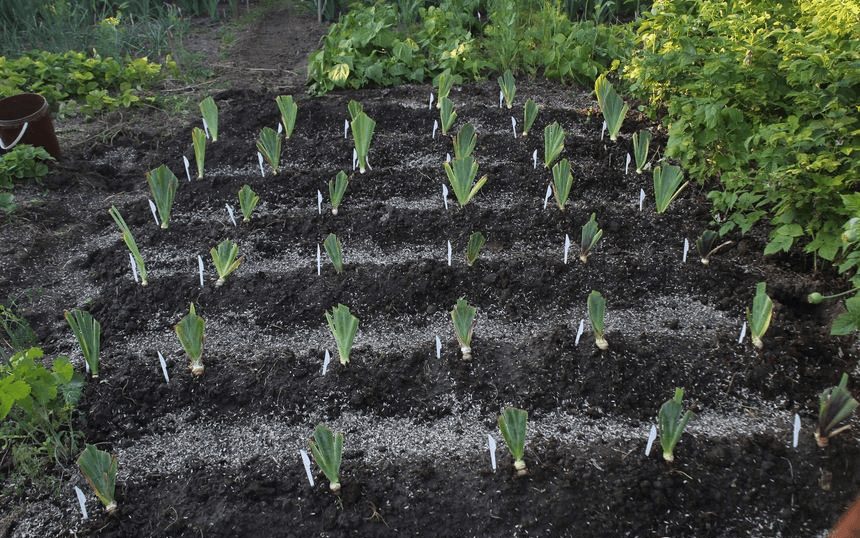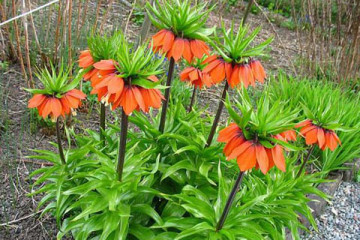Iris care after flowering - when to prune the leaves
Content:
- Iris care after flowering
- How to get iris seeds after flowering
- When to prune irises after flowering
- When to prune iris leaves
- Features of pruning some varieties
- Fertilizing irises after flowering
- How to split irises
- Site selection and soil preparation
- How to arrange iris combs
- Landing patterns
- How to properly plant a faded iris sprout
- Shelter for the winter
Irises are a bright decoration of many flower beds. They are in demand and popular among gardeners. There are more than 800 species in total. Therefore, the choice can be difficult. The most common varieties are Japanese and bearded. Irises are bush plants. Mostly easy to clean. In growing, the main thing is to prune in time after flowering and transplant. Most often, flowers undergo several types of processing. What should be done after the flowering culture? How to take care in the future? More details below in the article.
Iris care after flowering
Irises are incredibly beautiful flowers. They decorate flower beds, but at the same time, after flowering, they require care. For example, flowers and stems should be removed. However, you should be more careful about pruning foliage so as not to harm the roots.
Removing individual flowers, stems and foliage
During spring and summer, irises should be pruned. It is recommended to use special garden tools to remove dried plant parts. For example, pruning shears or scissors with sharp blades. Poor pruning can severely damage the plant.
So, to remove wilted flowers, you need to prune along the peduncles. More specifically: cut off the receptacle and the bud. At the same time, departing 2 cm from the selected bud. When the stem has completely bloomed, you should cut it two centimeters above the ground. Bushes should be checked for dried flowers once a week. This is quite enough.
Next comes the question of removing leaves. They should not be removed. They store and conduct nutrients and solar energy to the roots. This will be especially useful in the future in the winter season. In particular, the leaves contribute to the landscaping of flower beds, play the role of decor. The exception is yellow and dried parts. You need to get rid of them.
How to get iris seeds after flowering
As you know, many people breed irises by dividing rhizomes. This is not the only way. Seed planting is no less popular. When the flowering is over, you need to pick one bud and wait. Time is important for ripening.
Seed collection and germination
After a while, ripening is completed. Further, you should not overlook the process of opening the ovule. Collect seeds. Otherwise, the plant will shed them on its own.
The main rule when germinating seeds is to maintain the temperature. It should be roomy. The place where future sprouts are located is dry. Before sowing, it is better to keep the seeds in the cold, and then soak them in water for two days.
When to prune irises after flowering
Flowers such as irises require care after flowering.With its constant observance, the flower beds will definitely delight the eye. One of the most popular questions is the iris pruning process. If necessary? How often? How is it correct? When?
Do I need to trim faded irises
Irises have faded, but in reality few people know what to do with them.
After all, this is a common question that torments gardeners. The answer is simple: it is necessary to cut the plant. The reason for this is the ripening of the seeds, which soon begin to crumble. The process is called self-seeding. If you do not control this phenomenon, then the site will quickly become overcast with flowers. Then all beauty will lose its meaning.
When to prune iris leaves
Iris leaves are an important part of the plant. They store many minerals. They also serve as a conductive tissue. So, for example, solar energy and oxygen enter the plant. Therefore, experts do not recommend cutting them in the summer. Without them, the flower will suffer and possibly freeze. The best time for pruning is autumn, a few weeks before frost.
When and how to prune irises in the fall
Of course, you also need to know when to trim the irises.
The first step is to determine what autumn is in the region in a particular year. The pruning time depends on this. Most often, the process falls in the middle - end of October.
This is a measure that is necessary for the plant, because if prevention is not followed, insects or pests will lay larvae and eggs. Then in the spring the flower bed will be in a deplorable state. It is advised to cut the leaves in the form of a cone so that water does not accumulate. Otherwise, mold may appear, for example, widespread bloom - a type of mold, expressed by a pale green bloom.
Features of pruning some varieties
Some varieties recommend pruning in different ways. Depends on the conditions in which the plant is located and special requirements. This is why many are wondering when to prune different types of irises after flowering.
- Exotic. Removing foliage by half of the entire growth. Preferably in August.
- Bulbous. It is worth removing the leaves completely.
- Rhizome. Trimming only when necessary, such as yellow and dry parts.
Fertilizing irises after flowering
Irises respond well to fertilizers. After their introduction, they bloom more beautiful and magnificently. The risk of disease is reduced. In this case, it is important to correctly select organic and inorganic substances. For example, these plants respond positively to potash fertilizers, as well as phosphorus ones. It is important to feed the flower beds in time. It is worth making 3 top dressing per year: 2 in spring and 1 in autumn.
Fertilizers for lush iris bloom next year
Further, what types of fertilizers should be introduced to irises, depending on the season, about their measure and necessity.
Autumn fertilizers
They are applied three weeks after flowering. In this case, the flower is already dormant. Then, the growth of young roots occurs, so feeding during this period is necessary.
In early September, flower beds are fertilized with a potassium-phosphorus composition. Be sure to observe the ratio 3: 2. Other feedings are also needed: potassium salt, superphosphate, organic additives. For 1 m², you need to take 55 g of superphosphate and 25 g of salt. It is important not to forget about the proportions, to observe them.
The above fertilizers will not save you from pests. In this situation, it is enough just to spray the flower beds with Bordeaux liquid. So they will be reliably protected until the arrival of spring.
Spring fertilizers
Active growth occurs in the spring. To accelerate and maintain it, it is worth introducing fertilizers.
The very first feeding takes place immediately after winter after the snow melts. It is necessary to include the same potassium-phosphorus, as well as nitrogen fertilizers. Nitrogen supplements are especially needed in the early period. However, they are recommended to be introduced no later than July. Their need is for the plant to grow stronger, gain strength, and slowly prepare for reproduction. But here the proportions change slightly and are 2: 3: 2.5. The main thing is not to overfeed the beds, otherwise there will come a period of deposition of minerals - fattening. For flowers, this is fraught with consequences.
For special protection against insects and other dangerous pests, gardeners recommend covering the soil with wood ash. Consumption is 2 tbsp. spoons on a flower.
How to split irises
Correct planting and division is important for these plants. But for what purpose is a transplant required? These flowers can easily grow in one place for 4-5 years. Then the roots grow so much that the soil becomes cramped. The flower beds begin to wither, they hardly bloom. There is a sharp lack of mineral and nutrients. Of course, there are plants that can grow in one place for up to 10 years. These include Siberian irises. But still, most are not adapted to such conditions, so transplanting plays an important role in iris.
Transplanting irises in autumn
One of the fastest ways is to transplant with a clod of earth, but there are some nuances here. Such operations will take place only with young flowers, since their roots have not yet had time to grow.
Step-by-step transplant using the root division method:
- Dig up the bush completely, while being as careful as possible, without damaging the root system.
- Clear the roots of the bush from the ground. Then slowly divide it into larger pieces.
- With the help of special sharp tools, divide the roots even more (up to one or two accrete links).
- Too mature or rotten parts of the rhizome must be cut off.
- Thoroughly clean the black roots (cut off as a last resort).
- Hold the final parts of the bush in a fungicide. This solution is capable of disfiguring the surface from diseases.
- Prune the leaves (15 cm high). Fan-shaped is preferable.
- Transplant the plant into soil.
This is not all. Gardeners recommend that you familiarize yourself with the features of planting roots:
- Dry the treated roots. More remarkable a few days before disembarkation.
- You can transplant this culture immediately after flowering. It doesn't depend on the season. This is mainly summer and the first month of autumn. At this point, the roots are usually already strengthening.
Site selection and soil preparation
Most suitable for flowers such as irises are soil containing a little clay and sand (loam). Clay perfectly moisturizes the composition, and sand makes it lighter and adds looseness. Add peat to add lightness.
But as for the location, it is recommended to land on a well-lit and warm side. Irises don't like shade.
When disembarking, you should prepare the site. Irises should be planted at a low elevation.They cannot be planted in pits. The rhizome edge should protrude 5 mm. They do this so that it warms up thoroughly and does not rot. This is the key to healthy kidneys in the future.
Preparing for planting iris in open ground
After reading the above, it becomes clear that most often irises are transplanted at the end of summer. How to properly prepare the future soil and the flower itself?
The flower should be carefully trimmed. As mentioned, once a week.
It is worth slowly introducing fertilizers into the soil. For example, ash (2 cups), a bucket of humus, superphosphate (about half a cup), and a bucket of sand. Then dig everything up. Sprinkle with water periodically. Such soil will serve as an excellent basis for a new flower bed of irises.
Preparing pits for irises
You need to dig a hole. The hole should be free, slightly larger than the rhizome. Then pour some sand on the bottom. Place the plant inside. Spread out the roots carefully.
The distance between the bushes must be respected. It should be at least 30 cm. Ideally, 50 cm. Thus, the flowers will definitely not interfere with each other. Then the flower bed should be slightly raised. After all, irises are advised to grow on the hills.
How to arrange iris combs
It is necessary to dig a bed 80 cm wide. It is also allowed to dig a few, but observe the distance between them. Next, take a rake and make a long slide with a small depression in the middle. Then pour water over, let stand and absorb.
Next, you need to calculate the time that the flowers will spend in the combs. If it is 1-2 years, you can leave a space between the plants 20-25 cm. If a longer period of time is planned, the distance increases. Because irises require a wide area for root growth.
Landing patterns
There are many different planting patterns now. Only the most suitable for irises are listed here. The peculiarities of their structure must be taken into account, not forgetting that their growth occurs in breadth.
- "Chess". The meaning of the seating is that you need to plant flowers alternately, maintaining a minimum distance of 40-50 cm.
- "In pursuit". The main feature is that all flowers are planted in one direction, forming a beautiful pattern with leaves. Distance 30-45 cm.
- "In a circle". The plants are planted in a circle. In this case, the required distance is only 30 cm (in diameter).
With proper care and attention, irises can create an extraordinary composition in a flower bed. They look bright and light.
How to properly plant a faded iris sprout
For this procedure, you need to dig a shallow hole. Add a handful of sand. It is needed to maintain the lightness of the soil. Then place the plant vertically, sprinkling it with earth. Then pour a little. Water every four days for the next two weeks. The decay process must not be allowed due to excess moisture.
After replanting every 5 years. Fertilize three times a year.
Shelter for the winter
Planted plants should be covered with a layer of peat or ordinary earth. This should be done only at a stable temperature of 4-5 ° C before the first frost. In extremely cold conditions or snowless winters, it becomes necessary to cover the flower beds. For example, dry spruce branches or leaves will do.
The main thing is to open access to fresh air in the spring after the snow melts, when the plants enter the active growth phase.
Thus, this culture is not whimsical, does not require special care. However, in order for the flower bed to only become more magnificent, some rules should be followed. Then the flowers will delight the gardener's eye again and again.























